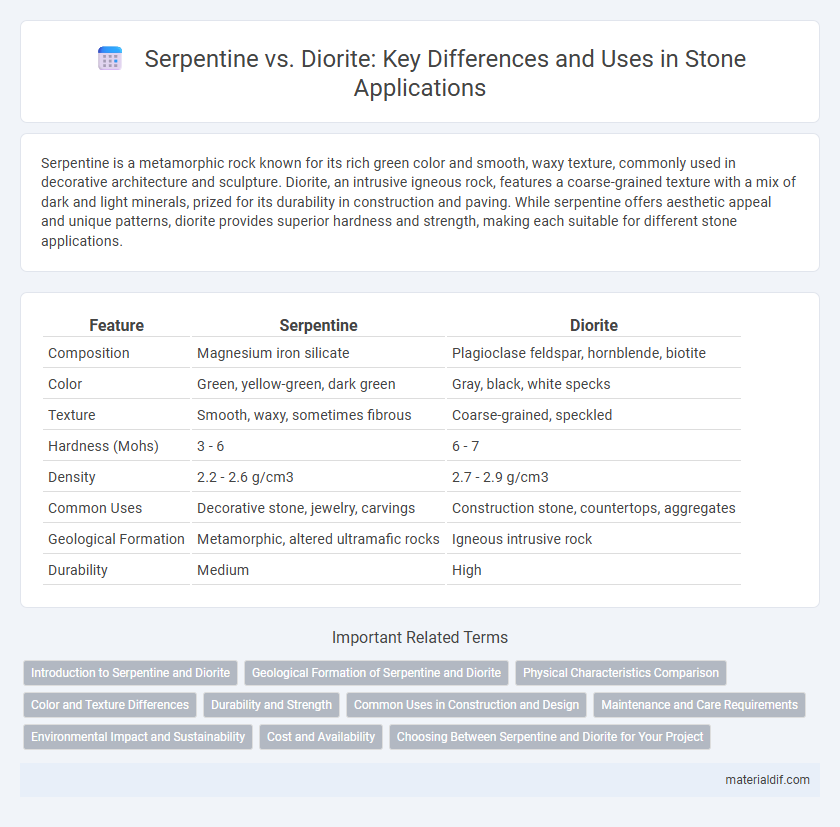Serpentine is a metamorphic rock known for its rich green color and smooth, waxy texture, commonly used in decorative architecture and sculpture. Diorite, an intrusive igneous rock, features a coarse-grained texture with a mix of dark and light minerals, prized for its durability in construction and paving. While serpentine offers aesthetic appeal and unique patterns, diorite provides superior hardness and strength, making each suitable for different stone applications.
Table of Comparison
| Feature | Serpentine | Diorite |
|---|---|---|
| Composition | Magnesium iron silicate | Plagioclase feldspar, hornblende, biotite |
| Color | Green, yellow-green, dark green | Gray, black, white specks |
| Texture | Smooth, waxy, sometimes fibrous | Coarse-grained, speckled |
| Hardness (Mohs) | 3 - 6 | 6 - 7 |
| Density | 2.2 - 2.6 g/cm3 | 2.7 - 2.9 g/cm3 |
| Common Uses | Decorative stone, jewelry, carvings | Construction stone, countertops, aggregates |
| Geological Formation | Metamorphic, altered ultramafic rocks | Igneous intrusive rock |
| Durability | Medium | High |
Introduction to Serpentine and Diorite
Serpentine is a group of greenish, often mottled metamorphic rocks known for their smooth or scaly appearance and a silky or waxy luster, primarily composed of magnesium silicate minerals. Diorite, an intrusive igneous rock, features a coarse-grained texture with a composition dominated by plagioclase feldspar and hornblende or biotite, often exhibiting a salt-and-pepper appearance. Both stones are valued for their durability and aesthetic properties, used extensively in construction, sculpture, and ornamental applications.
Geological Formation of Serpentine and Diorite
Serpentine forms through the metamorphic alteration of ultramafic rocks, primarily peridotite, in a process called serpentinization, where magnesium-rich minerals react with water at low temperatures and moderate pressures. Diorite crystallizes from intermediate magmas during slow cooling within the Earth's crust, resulting in a coarse-grained intrusive igneous rock composed mainly of plagioclase feldspar and amphibole. The distinct geological formation processes of serpentine and diorite reflect their origins as metamorphic and igneous rocks, respectively.
Physical Characteristics Comparison
Serpentine exhibits a smooth, often waxy texture with a greenish hue, making it ideal for ornamental stone and architectural applications. Diorite features a coarse-grained, speckled appearance with black and white minerals, offering exceptional durability and strength for construction and paving. The distinct grain size and color differentiate serpentine's softer, malleable properties from diorite's hard, dense, and resistant nature.
Color and Texture Differences
Serpentine features a distinctive green coloration with smooth, waxy textures, often displaying a mottled or veined pattern that enhances its decorative appeal. Diorite exhibits a speckled black-and-white or salt-and-pepper appearance with a coarse-grained, granular texture, resulting from the interlocking crystals of feldspar and quartz. The color contrast and texture variation between serpentine's vibrant hues and diorite's monochromatic, coarse feel make each stone unique for architectural and sculptural applications.
Durability and Strength
Serpentine exhibits moderate durability with a Mohs hardness of 3 to 6, making it less resistant to weathering compared to diorite, which has a higher hardness of 6 to 7 and exceptional compressive strength ideal for construction. Diorite's coarse-grained texture and interlocking crystals contribute to its superior strength and durability, often used in heavy-duty applications such as building stones and monuments. While serpentine offers aesthetic appeal with its greenish hues and smooth texture, diorite remains the preferred choice where high strength and long-term durability are critical.
Common Uses in Construction and Design
Serpentine stone, valued for its rich green hues and smooth texture, is commonly used in interior applications such as countertops, wall tiles, and decorative veneers, offering aesthetic appeal and moderate durability. Diorite, characterized by its coarse-grained texture and speckled black-and-white appearance, is favored for structural elements including paving, stairs, and building facades due to its high strength and resistance to weathering. Both stones enhance architectural design, but serpentine suits ornamental purposes while diorite excels in load-bearing and exterior construction.
Maintenance and Care Requirements
Serpentine requires regular sealing due to its porous nature, making it more susceptible to staining and etching compared to diorite. Diorite is denser and harder, resulting in lower maintenance with less frequent sealing and greater resistance to scratches and acids. Proper cleaning for serpentine involves mild, pH-neutral solutions, whereas diorite can withstand stronger detergents without damage.
Environmental Impact and Sustainability
Serpentine stone typically has a lower environmental impact compared to diorite due to its natural abundance and less intensive mining processes, which reduce habitat disruption and energy consumption. Diorite extraction often involves more invasive mining techniques and higher carbon emissions, making it less sustainable in quarrying contexts. Choosing serpentine supports sustainable construction practices by minimizing ecological damage and promoting responsible resource use.
Cost and Availability
Serpentine stone is generally more affordable and widely available due to its common occurrence in metamorphic rock formations. Diorite, being a coarse-grained igneous rock, tends to be more expensive because of its limited quarry locations and higher demand in luxury applications. Cost variations between serpentine and diorite also depend on factors like color uniformity, finishing quality, and import restrictions.
Choosing Between Serpentine and Diorite for Your Project
Serpentine and diorite offer distinct advantages for construction and design, with serpentine providing a unique greenish hue and excellent heat resistance, making it ideal for decorative applications and interior surfaces. Diorite, characterized by its coarse-grained texture and durability, excels in structural uses and outdoor projects requiring high compressive strength. Selecting between serpentine and diorite depends on aesthetic preferences, environmental exposure, and the specific functional demands of your project, such as wear resistance and color variation.
Serpentine vs Diorite Infographic

 materialdif.com
materialdif.com